Difference between revisions of "Group27 Report"
Xymeng.2017 (talk | contribs) (Created page with "<div style="background:#17202A; padding:22px; text-align:center;"> <font size = 7; color="#FFC300"><span style="font-family: Calibri;">Urban Pulse: A Case Study on Beijing's...") |
Xymeng.2017 (talk | contribs) |
||
| Line 1: | Line 1: | ||
| − | <div style= | + | <!--ABSTRACT--> |
| − | <font size = | + | |
| + | <div style=background:#F6CECE border:#A3BFB1> | ||
| + | [[File:Airbnb-newyork.jpg|400px|frameless]] | ||
| + | <b><font size = 6; color="#8B4513"> Group27:Airbnb Crisis in NYC</font></b> | ||
</div> | </div> | ||
| − | {|style="background-color:# | + | <!--Navigation--> |
| + | {| style=" padding: 5px 0 0 0;" width="100%" cellspacing="0" cellpadding="0" valign="top" border="0" | | ||
| + | | style="padding:0.3em; font-size:120%; background-color:#ff7575; border:solid 1px #FF9797; border-bottom:2px solid #750000; text-align:center" width="12%" | [[Group27_Overview | <font color="#FFFFFF" face="Calibri Light"><b>Overview</b></font> ]] | ||
| − | | style=" | + | | style="border-bottom:1px solid #750000; background: none;" width="2%" | |
| − | [[ | + | | style="padding:0.3em; font-size:120%; background-color:#ff7575; border:solid 1px #FF9797; border-bottom:1px solid #750000; text-align:center" width="12%" | [[Group27_Proposal | <font color="#FFFFFF" face="Calibri Light"><b><u>Proposal</u></b></font> ]] |
| − | | style=" | + | | style="border-bottom:1px solid #750000; background:none;" width="2%" | |
| − | [[ | + | | style="padding:0.3em; font-size:120%; background-color:#ff7575; border:solid 1px #FF9797; border-bottom:1px solid #750000; text-align:center" width="12%" | [[Group27_Poster | <font color="#FFFFFF" face="Calibri Light"><b>Poster</b></font> ]] |
| − | | style=" | + | | style="border-bottom:1px solid #750000; background:none;" width="2%" | |
| − | [[ | + | | style="padding:0.3em; font-size:120%; background-color:#ff7575; border:solid 1px #FF9797; border-bottom:1px solid #750000; text-align:center" width="12%" | [[Group27_Application | <font color="#FFFFFF" face="Calibri Light"><b>Application</b></font> ]] |
| − | | style=" | + | | style="border-bottom:1px solid #750000; background:none;" width="2%" | |
| − | [[ | + | | style="padding:0.3em; font-size:120%; background-color:#ff7575; border:solid 1px #FF9797; border-bottom:1px solid #750000; text-align:center" width="12%" | [[Group27_Report | <font color="#FFFFFF" face="Calibri Light"><b>Report</b></font> ]] |
|} | |} | ||
| + | |||
| + | ==<font size="5"><font color="#000000">'''Airbnb in New York City'''</font></font>== | ||
| Line 61: | Line 68: | ||
==== Visualization of Traffic patterns by hour of the day ==== | ==== Visualization of Traffic patterns by hour of the day ==== | ||
| − | |||
| − | |||
| − | |||
| − | |||
| − | |||
| − | |||
| − | |||
| − | |||
| − | |||
| − | |||
| − | |||
| − | |||
| − | |||
| − | |||
| − | |||
| − | |||
Revision as of 17:41, 13 August 2018
| Overview | Proposal | Poster | Application | Report |
Contents
Airbnb in New York City
INTRODUCTION
- 1.1 Background
Airbnb is developing fast in recent years, it boasts almost two million listings in 34,000 cities, and according to data from Inside Airbnb, an independent data analysis website. listed about 36000 apartments in New York, which is the one of the biggest markets of Airbnb. However, The New York State Attorney General concluded that 72%of all units used as private short-term rentals on Airbnb during recent years appeared to violate both state and local New York laws. New York’s short-term rental laws, which were last updated in 2010, basically prohibit most apartments (buildings with three or more units) in New York City from being rented out for less than 30 days. Therefore, majority of entire home/apartment listings that you find on Airbnb and other sites for New York City would be considered illegal, especially if you can book them for a period of less than 30 days. Meanwhile, some hosts are purchasing more properties to extend their operating range, we call them commercial operator. Our project mainly has two objects: 1) Explore and visualize how Airbnb operates in New York City 2) Figure out how the New York’s short-term rental laws affect illegal listings and commercial operator in three years.
- 1.2 Motivation
With the developing of Airbnb in New York, an increasing number of hosts have incentive to operate their property as Airbnb for listing short-term rental instead of lending out. In this context, two kinds of host emerged. Commercial Airbnb operators, who have multiple entire-home listings or large portfolios of private rooms, they operate Airbnb as business. Illegal hosts, who might not operate many listings and treat Airbnb as business, they are more willing to gain benefits based on their own property. Looking for quick return is their strategy. Based on these situation, we will explore the relationship among hosts, Airbnb NYC and New York’s short-term rental laws.
Data Preparation
Our dataset is from Inside Airbnb, these three csv files contain summary information and metrics for listings in New York City of 2015 to 2017. We deleted useless variables and summarized the listing which is illegal and the host which is commercial operator by using JMP and R.
TECHNICAL APPROACH
To visualize the overview of Airbnb in NYC and our statistical analysis, we applied several useful R packages:
Page 2 - Find traffic patterns by statistical analysis
This page is mainly about the statistic analysis of traffic patterns in Beijing. We focus on the speed, number of taxis and distance which drivers traveled by district level and try to give our users more explicit idea about traffic in Beijing.
Package used: Leaflet, ggplot, plotly
Details of design:
- Layout: layout of this page is shown below. On the left side, we have a map of Beijing by district level. And on the right side, there are three line graphs showing the speed, number of taxis, and distance by hour and date. The reason why we show map and line graph together is that we want our users to have an intuitive idea about the how Beijing looks like and where is the specific district located. This may help them figure out why more taxi drivers would like to spend most of them time traveling in districts like Haidian but not like Fangshan.
Page 3 - Analyze the working pattern of Beijing taxi drivers
This page focuses on finding the behaviour of the taxi drivers.
1.The left interactive graph enables the user to select a taxi driver id and find where he lives and in which district he's driving at a specific time point. Take user 1000 as an example. ... After random sampling 20 drivers, we found that most drivers tend to drive near their living place and they like to drive around one district for 2-3 hours.
2. The top right part is a heat map reflecting the distribution of drivers' living places. The redder the area is, the higher density it is for driver home. 3. The bottom right part are two graphs giving statistics of the drivers' working days and working hour, including a comparison between normal working days (02-05) and lunar new year period(06-07).
Discussion
Visualization of Traffic patterns by hour of the day
Heat Map of home addresses and starting points for taxis per day
The plot below represents the specific locations of the 10357 taxis drivers' home in Beijing. Having no information of the drivers' profile, we derived their home location by computing the longest time period during which the car speed remains 0 km/h for each drive , and assume that specific location to be the driver's home.
Insights on working patterns for taxi drivers in Beijing
In this section we dug deeeper into Taxi behaviour to get specific insights on number of working hours, number of taxis per hour and how many days a week taxi drivers work in this Beijing sample.
The number of taxis per hour is represented below. We can observe that the number of hours in public holidays diminishes, as we assumed. Finally, the number of hours increases from 10am and peaks at 15 hours in both inside and outside inner circle.
Opposite to that, the speed increases as the traffic (and number of hours) reduces such as in Chinese New Year.
Total distance during the night reaches a minimum and increases from 9am during the day until 9pm.
We have analyzed in R the Number of working days for the 10357 taxis. The distribution of this data is represented in the chart below. As we can see over 6500 taxis or almost 63% of the taxi fleet works 7 days a week while 20% of the fleet in this data works 6 days a week. There’s a very small percentage of taxi drivers working 4 or less number of days in a week.
Finally, we show the distribution of the number of working hours for the 10357 taxi drivers in our dataset.
Future work
Beijing is one of the busiest cities in the world. From a simple dataset of 4 variables: Taxi ID, Latitude, Longitude and Timestamp the team has managed to derive insights from different angles on Taxi driver behaviour, traffic patterns and other distributions.
This data analysis could be useful for Beijing’s municipalities. It could also serve as a research paper and tool for new start-ups who want to understand the taxi patterns and locations in Beijing.
Other uses of this research are:
- For Government: Due to limited information for Beijing's city construction and road planning, we may only give suggestions based on our cognition. The suggestions may not be applicable in real world, but it gives a general direction of how to mitigate congestion by improving the traffic arrangements. - For Taxi Companoies: We will suggest taxi companies in Beijing how to allocate taxis in a more efficient way. - For Commuters: Commuters may have a more clear view of the traffic condition at different time and site to make cleverer decisions on their transportation planning.
The data used for this analysis is dated 2008, however, it would be relevant to apply it to a more recent dataset and real time data. Future work can consist of mapping a real time dataset with our application.
Overall, the team has demonstrated that by taking periodical samples of position for no matter what vehicle, useful insights can be derived for decision making.
Installation Guide
Here are the steps for the installation: 1. 2. 3.
User Guide
The Shiny application has 4 tabs:
- [1] First tab shows the data set. User can take a look at the different variables including the ones derived during the project
- [2] Second tab shows an initial visualization for exploratory purposes. One can clearly see the map of beijing and the different traffic patters. This is only for visualization purposes
- [3] Third tab explores the different traffic patterns per district and per day and hour.
- [4] Fourth tab in our Shiny R app includes taxi driver behavior. One can select a specific taxi ID and understand where this taxi driver is at each point of the day.
Acknowledgements
The authors wish to thank Ting Seong KAM, professor of Visual analytics in School of Information Systems, Singapore Management University for his ongoing support.
References
- [1] Introductory statistics with R. By Peter Dalgaard published in 2002.
- [2] Tutorials from Datacamp on R visualization and ShinyR
- [3] R Graphics cookbook by Winston Chang, 2012
- [4] Data Visualization with R: 100 examples by Thomas Rahlf, published in 2017.
- [5] T-Drive: Driving directions based on taxi trajectories pdf. By Microsoft November 1, 2010
- [6] Urban computing with Taxicabs, October 20th, 2011
- [7] Analyzing 1.1Billion NYC Taxi and Uber trips by Todd Schneider, 2018
- [8] The Art of R Programming: A Tour of Statistical Software Design Book by Norman Matloff
- [9] R in a Nutshell Book by Joseph Adle
- [10] Using R for Introductory Statistics Textbook by John Verzani
- [11] R for Data Science Book by Garrett Grolemund and Hadley Wickham
- [12] Learning Shiny | R-bloggers
- [13] Web Application Development with R Using Shiny by Chris Beeley




